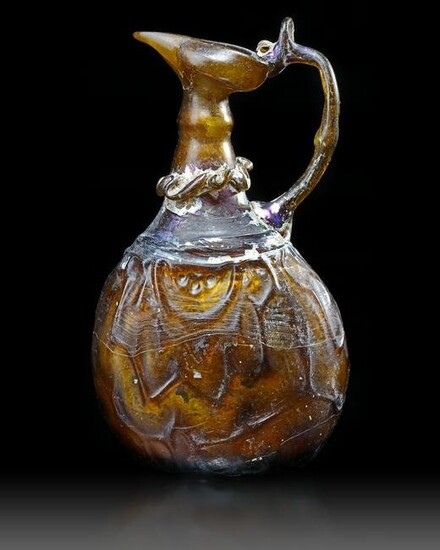AN AMBER GLASS JUG, PERSIA, 10TH-11TH CENTURY
This alluring glass jug is a fine example of Islamic glass making from the early Medieval Islamic Period. Glass making production after the fall of the Roman Empire fell in to decline across the Near East, except for in the areas of modern day Egypt, Syria and Iraq, where its traditions continued, being passed on to Medieval craftsmen. As furnace technology improved, allowing wider variety of production, many new styles evolved, and the early Medieval Period between the 8th and the 12th centuries produced some of the most unique and playful glass from the across of Islamic world, little of which unfortunately survives due to its fragile nature . This fine example consists of a rounded body, made using the dip-moulding technique where a parison of molten glass is be dipped in to a mould then tooled, blown or manipulated against the edges in to various forms . It exhibits a characteristic softly moulded pattern of raised, rolling lines across the body of the glass that radiate from the upper body in irregular curves, adding an element of decoration. This effect is achievable through the dip-mould technique and adds a sense of dynamism to the jug, making it appear almost organic, whilst the rich colour was probably achieved with the addition of Manganese inclusions during the melting process . The narrow neck, with a single ridged detail tapers to a drop-shaped spout with a slightly inverted rim that sits above a beautiful section of detailing around the neck of an undulating trail design of thick glass. A separately moulded glass handle applied when the body was still hot also exhibits and elegant trail motif at the upper end. 15 cm. heightCATALOGUE NOTE A similar glass jug exists in the Metropolitan Museum of Art in New York, from modern day Iraq. This example has a similar globular shaped moulded body, with applied glass detail and handle, but lacks the deep colour, finesse of detail, and alluring shape of our example, whilst also of smaller size and in worse condition. It suggests our glass jug could take pride of place in any museum or private collection. For more information see; S. Carboni, Glass from Islamic Lands, The al-Sabah Collection, Kuwait National Museum, London 2001. G.F. Bass et al.; ‪Serçe Limani, Vol 2: The Glass of an Eleventh-Century Shipwreck‬, Texas University Press, 2009, p.468.
[ translate ]Estimate
Time, Location
Auction House
This alluring glass jug is a fine example of Islamic glass making from the early Medieval Islamic Period. Glass making production after the fall of the Roman Empire fell in to decline across the Near East, except for in the areas of modern day Egypt, Syria and Iraq, where its traditions continued, being passed on to Medieval craftsmen. As furnace technology improved, allowing wider variety of production, many new styles evolved, and the early Medieval Period between the 8th and the 12th centuries produced some of the most unique and playful glass from the across of Islamic world, little of which unfortunately survives due to its fragile nature . This fine example consists of a rounded body, made using the dip-moulding technique where a parison of molten glass is be dipped in to a mould then tooled, blown or manipulated against the edges in to various forms . It exhibits a characteristic softly moulded pattern of raised, rolling lines across the body of the glass that radiate from the upper body in irregular curves, adding an element of decoration. This effect is achievable through the dip-mould technique and adds a sense of dynamism to the jug, making it appear almost organic, whilst the rich colour was probably achieved with the addition of Manganese inclusions during the melting process . The narrow neck, with a single ridged detail tapers to a drop-shaped spout with a slightly inverted rim that sits above a beautiful section of detailing around the neck of an undulating trail design of thick glass. A separately moulded glass handle applied when the body was still hot also exhibits and elegant trail motif at the upper end. 15 cm. heightCATALOGUE NOTE A similar glass jug exists in the Metropolitan Museum of Art in New York, from modern day Iraq. This example has a similar globular shaped moulded body, with applied glass detail and handle, but lacks the deep colour, finesse of detail, and alluring shape of our example, whilst also of smaller size and in worse condition. It suggests our glass jug could take pride of place in any museum or private collection. For more information see; S. Carboni, Glass from Islamic Lands, The al-Sabah Collection, Kuwait National Museum, London 2001. G.F. Bass et al.; ‪Serçe Limani, Vol 2: The Glass of an Eleventh-Century Shipwreck‬, Texas University Press, 2009, p.468.
[ translate ]


